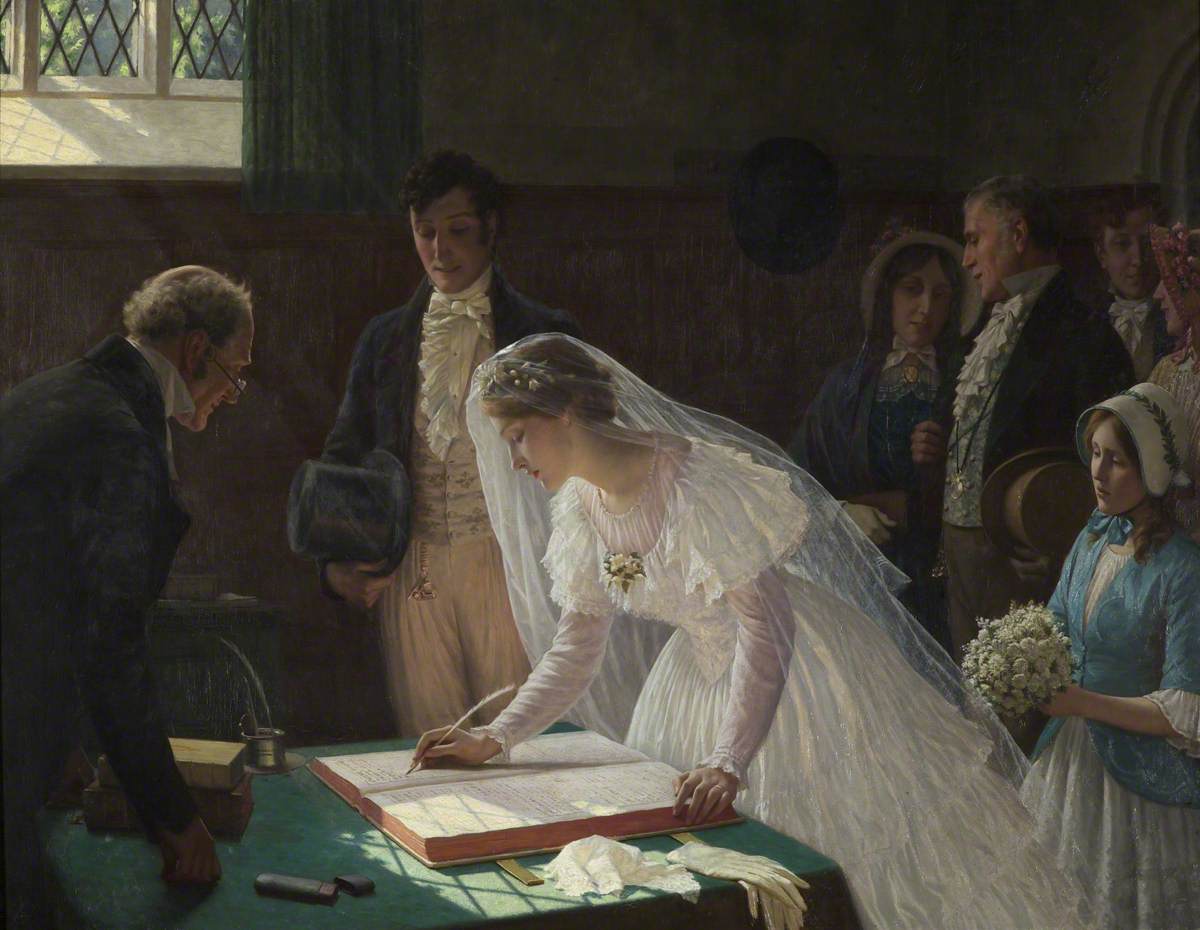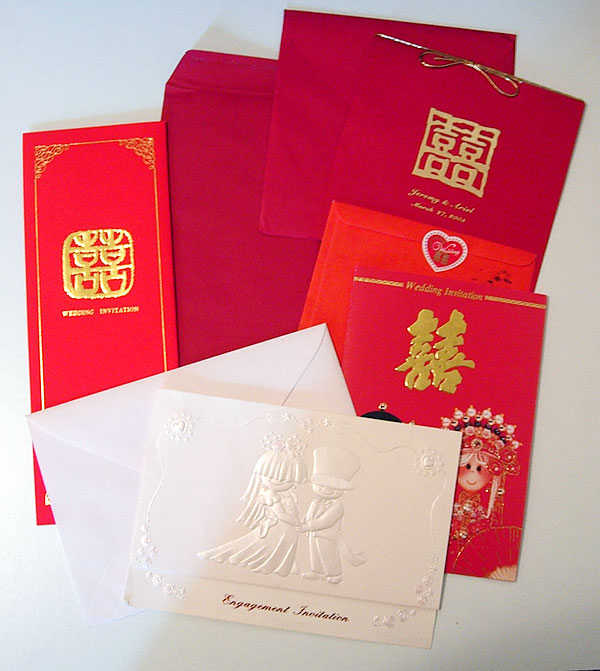|
Bridesmaid
Bridesmaids are members of the bride's party at some Western traditional wedding ceremonies. A bridesmaid is typically a young woman and often the bride's close friend or relative. She attends to the bride on the day of a wedding or marriage ceremony. Traditionally, bridesmaids were chosen from unwed young women of marriageable age. The principal bridesmaid, if one is designated, may be called the chief bridesmaid. She may also be called the maid of honor if she is unmarried, or the matron of honor if she is married. A junior bridesmaid is a girl who is clearly too young to be married but who is included as a bridesmaid anyway. In the United States, typically only the maid or matron of honor and the best man are considered official witnesses for the wedding license. Often there is more than one bridesmaid; in modern times the bride chooses how many to ask. Historically, no person of status went out unattended, and the size of the retinue was closely calculated to be appropriat ... [...More Info...] [...Related Items...] OR: [Wikipedia] [Google] [Baidu] |
Bridesmaid And Junior Bridesmaid-crop
Bridesmaids are members of the bride's party at some Western culture, Western traditional wedding ceremonies. A bridesmaid is typically a young woman and often the bride's close friend or relative. She attends to the bride on the day of a wedding or marriage ceremony. Traditionally, bridesmaids were chosen from unwed young women of marriageable age. The principal bridesmaid, if one is designated, may be called the chief bridesmaid. She may also be called the maid of honor if she is unmarried, or the matron of honor if she is married. A junior bridesmaid is a girl who is clearly too young to be married but who is included as a bridesmaid anyway. In the United States, typically only the maid or matron of honor and the best man are considered official witnesses for the wedding license. Often there is more than one bridesmaid; in modern times the bride chooses how many to ask. Historically, no person of status went out unattended, and the size of the retinue was closely calculated ... [...More Info...] [...Related Items...] OR: [Wikipedia] [Google] [Baidu] |
Wedding
A wedding is a ceremony in which two people are united in marriage. Wedding traditions and customs vary greatly between cultures, ethnicity, ethnicities, Race (human categorization), races, religions, Religious denomination, denominations, Country, countries, social classes, and sexual orientations. Most wedding ceremonies involve an exchange of marriage vows by a couple; a presentation of a gift (e.g., an offering, rings, a symbolic item, flowers, money, or a dress); and a public proclamation of marriage by an authority figure or Celebrant (Australia), celebrant. Special wedding garments are often worn, and the ceremony is sometimes followed by a wedding reception. Music, poetry, prayers, or readings from religious texts or literature are also commonly incorporated into the ceremony, as well as Wedding superstitions, superstitious customs. Common elements across cultures Some cultures have adopted the traditional Western custom of the white wedding, in which a bride wear ... [...More Info...] [...Related Items...] OR: [Wikipedia] [Google] [Baidu] |
Bachelorette Party
A bachelorette party (United States and Canada) or hen night (United Kingdom, UK, Republic of Ireland, Ireland and Australia) is a party held for a woman (the bride or bride-to-be) who will soon be Marriage, married. While Beth Montemurro concludes that the bachelorette party is modelled after the centuries-old Bachelor party, stag night in the US, which is itself historically a dinner given by the bridegroom to his friends shortly before his wedding, Sheila Young argues that its British counterpart evolved from a number of earlier pre-wedding traditions for women (Ribbon Girl, Pay Off, Bosola, Taking Out, Jumping the Chanty, to name but a few) whose origins are obscure but which have been around for at least a century in factories and offices across the UK. Despite its reputation as "a sodden farewell to maiden days" or "an evening of debauchery", these events can simply be parties given in honor of the bride-to-be, in the style that is common to that social circle. Terminology ... [...More Info...] [...Related Items...] OR: [Wikipedia] [Google] [Baidu] |
Best Man
A groomsman or usher is one of the male attendants to the groom in a wedding ceremony. Usually, the groom selects close friends and relatives to serve as groomsmen, and it is considered an honor to be selected. From his groomsmen, the groom usually chooses one to serve as best man. For a wedding with many guests, the groom may also ask other male friends and relatives to act as ushers without otherwise participating in the wedding ceremony; their sole task is ushering guests to their seats before the ceremony. Ushers may also be hired for very large weddings. In a military officer's wedding, the roles of groomsmen are replaced by swordsmen of the sword honor guard. They are usually picked as close personal friends of the groom who have served with him. Their role includes forming the traditional saber arch for the married couple and guests to walk through. The first recorded use of the word ‘groomsmen’, according to the Oxford English Dictionary, was as recently as 1698, al ... [...More Info...] [...Related Items...] OR: [Wikipedia] [Google] [Baidu] |
Wedding Ring
A wedding ring or wedding band is a finger ring that indicates that its wearer is married. It is usually forged from metal, traditionally gold or another precious metal. Rings were used in ancient Rome during marriage. In western culture, a wedding ring is typically worn on the base of the left ring finger. The ring finger is widely claimed to be associated with the traditional belief known as ''vena amoris'' ("vein of love"). History The Western traditions of wedding rings can be traced to ancient Rome and Ancient Greece, Greece, and were first associated with the marital dowry and later with a promise of fidelity. The modern exchange of rings derived from the customs of Europe in the Middle Ages as part of Christendom. Historical styles Gimmel rings During the 16th and 17th centuries, European husbands bestowed a gimmel ring upon their wives. Similar to the puzzle ring, the gimmel ring consisted of two interlocking bands. The bride and groom both wore one of these ban ... [...More Info...] [...Related Items...] OR: [Wikipedia] [Google] [Baidu] |
Maid Of Honour
A maid of honour is a junior attendant of a queen in royal households. The position was and is junior to the lady-in-waiting. The equivalent title and office has historically been used in most European royal courts. Tudors and Stuarts Traditionally, a queen regnant had eight maids of honour, while a queen consort had four. Queen Anne Boleyn had seven maids of honour and one mother of maids. A maid of honour was a maiden, meaning that she had never been married (and therefore was ostensibly a virgin), and was usually young and a member of the nobility. Maids of honour were commonly in their sixteenth year or older, although Lady Jane Grey served as a maid of honour to Queen Catherine Parr in about 1546–48, when Jane was only about ten to twelve years old. Under Mary I and Elizabeth I, maids of honour were at court as a kind of finishing school, with the hope of making a good marriage. Elizabeth Knollys was a maid of the court at the age of nine. Elizabeth gave gifts of ... [...More Info...] [...Related Items...] OR: [Wikipedia] [Google] [Baidu] |
Queen Regnant
A queen regnant (: queens regnant) is a female monarch, equivalent in rank, title and position to a king. She reigns ''suo jure'' (in her own right) over a realm known as a kingdom; as opposed to a queen consort, who is married to a reigning king; or a queen ''regent'', who is the guardian of a child monarch and rules ''pro tempore'' in the child's stead or instead of her husband who is absent from the realm, be it in sharing power or in ruling alone. A queen ''regnant'' is sometimes called a woman king. A princess, duchess, or grand duchess regnant is a female monarch who reigns ''suo jure'' over a principality or (Grand duchy, grand) duchy; an empress regnant is a female monarch who reigns ''suo jure'' over an empire. A queen regnant possesses all the powers, Constitutional monarchy, such as they may be, of the monarchy, whereas a queen consort or queen regent shares her spouse's or child's rank and titles but does not share the sovereignty of her spouse or child. The hus ... [...More Info...] [...Related Items...] OR: [Wikipedia] [Google] [Baidu] |
Wedding Invitation
A wedding invitation is a letter asking the recipient to attend a wedding. It is typically written in the formal, grammatical, third-person language and mailed five to eight weeks before the wedding date. Like any other invitation, it is the privilege and duty of the host—historically, for younger brides in Western culture, the mother of the bride, on behalf of the bride's family—to issue invitations, either by sending them herself or causing them to be sent, either by enlisting the help of relatives, friends, or her social secretary to select the guest list and address envelopes, or by hiring a service. With computer technology, some are able to print directly on envelopes from a guest list using a mail merge with word processing and spreadsheet software. History The Middle Ages and before Prior to the invention of the moveable-type printing press by Johannes Gutenberg in 1447, weddings in England were typically announced by means of a Town crier: a man who would walk ... [...More Info...] [...Related Items...] OR: [Wikipedia] [Google] [Baidu] |
Western Culture
Western culture, also known as Western civilization, European civilization, Occidental culture, Western society, or simply the West, refers to the Cultural heritage, internally diverse culture of the Western world. The term "Western" encompasses the social norms, ethical values, Tradition, traditional customs, belief systems, political systems, Cultural artifact, artifacts and technology, technologies primarily rooted in History of Europe, European and History of the Mediterranean region, Mediterranean histories. A broad concept, "Western culture" does not relate to a region with fixed members or geographical confines. It generally refers to the classical era cultures of Ancient Greece and Ancient Rome that expanded across the Mediterranean basin and Europe, and later circulated around the world predominantly through colonization and globalization. Historically, scholars have closely associated the idea of Western culture with the classical era of Greco-Roman antiquity. Howeve ... [...More Info...] [...Related Items...] OR: [Wikipedia] [Google] [Baidu] |
Age Of Majority
The age of majority is the threshold of legal adulthood as recognized or declared in law. It is the moment when a person ceases to be considered a minor (law), minor, and assumes legal control over their person, actions, and decisions, thus terminating the control and legal responsibilities of their parents or guardian over them. Most countries set the age of majority at 18, but some jurisdictions have a higher age and others lower. The word ''majority'' here refers to having greater years and being of full age as opposed to ''minority'', the state of being a minor. The law in a given jurisdiction may not actually use the term "age of majority". The term refers to a collection of laws bestowing the status of adulthood. Explanation The term ''age of majority'' can be confused with the similar concept of the ''age of license''. As a legal term, ''license'' means ''permission'', referring to a legally enforceable right or privilege. Thus, the age of license for a specific activit ... [...More Info...] [...Related Items...] OR: [Wikipedia] [Google] [Baidu] |






